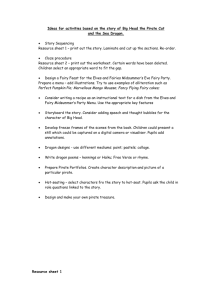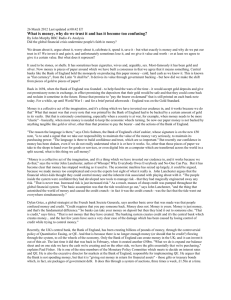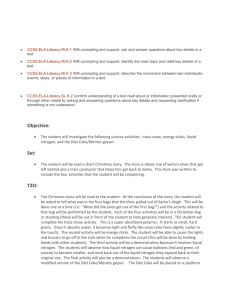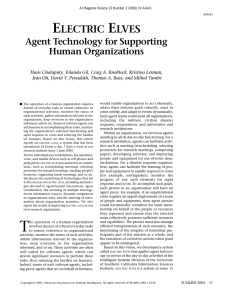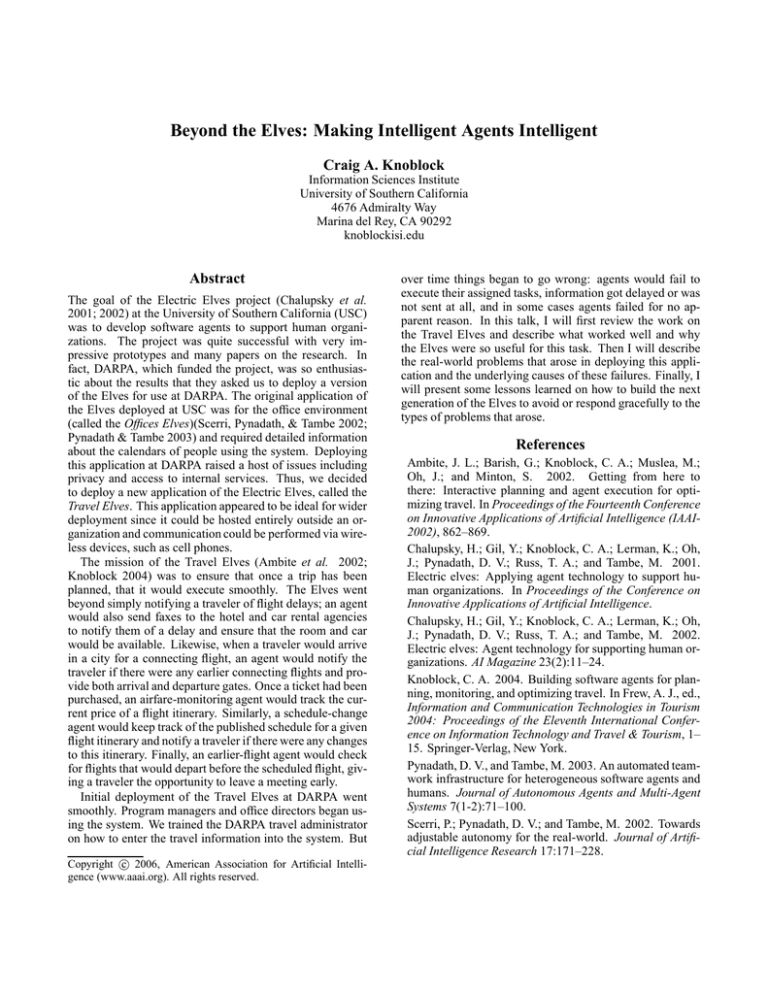
Beyond the Elves: Making Intelligent Agents Intelligent
Craig A. Knoblock
Information Sciences Institute
University of Southern California
4676 Admiralty Way
Marina del Rey, CA 90292
knoblockisi.edu
Abstract
The goal of the Electric Elves project (Chalupsky et al.
2001; 2002) at the University of Southern California (USC)
was to develop software agents to support human organizations. The project was quite successful with very impressive prototypes and many papers on the research. In
fact, DARPA, which funded the project, was so enthusiastic about the results that they asked us to deploy a version
of the Elves for use at DARPA. The original application of
the Elves deployed at USC was for the office environment
(called the Offices Elves)(Scerri, Pynadath, & Tambe 2002;
Pynadath & Tambe 2003) and required detailed information
about the calendars of people using the system. Deploying
this application at DARPA raised a host of issues including
privacy and access to internal services. Thus, we decided
to deploy a new application of the Electric Elves, called the
Travel Elves. This application appeared to be ideal for wider
deployment since it could be hosted entirely outside an organization and communication could be performed via wireless devices, such as cell phones.
The mission of the Travel Elves (Ambite et al. 2002;
Knoblock 2004) was to ensure that once a trip has been
planned, that it would execute smoothly. The Elves went
beyond simply notifying a traveler of flight delays; an agent
would also send faxes to the hotel and car rental agencies
to notify them of a delay and ensure that the room and car
would be available. Likewise, when a traveler would arrive
in a city for a connecting flight, an agent would notify the
traveler if there were any earlier connecting flights and provide both arrival and departure gates. Once a ticket had been
purchased, an airfare-monitoring agent would track the current price of a flight itinerary. Similarly, a schedule-change
agent would keep track of the published schedule for a given
flight itinerary and notify a traveler if there were any changes
to this itinerary. Finally, an earlier-flight agent would check
for flights that would depart before the scheduled flight, giving a traveler the opportunity to leave a meeting early.
Initial deployment of the Travel Elves at DARPA went
smoothly. Program managers and office directors began using the system. We trained the DARPA travel administrator
on how to enter the travel information into the system. But
c 2006, American Association for Artificial IntelliCopyright gence (www.aaai.org). All rights reserved.
over time things began to go wrong: agents would fail to
execute their assigned tasks, information got delayed or was
not sent at all, and in some cases agents failed for no apparent reason. In this talk, I will first review the work on
the Travel Elves and describe what worked well and why
the Elves were so useful for this task. Then I will describe
the real-world problems that arose in deploying this application and the underlying causes of these failures. Finally, I
will present some lessons learned on how to build the next
generation of the Elves to avoid or respond gracefully to the
types of problems that arose.
References
Ambite, J. L.; Barish, G.; Knoblock, C. A.; Muslea, M.;
Oh, J.; and Minton, S. 2002. Getting from here to
there: Interactive planning and agent execution for optimizing travel. In Proceedings of the Fourteenth Conference
on Innovative Applications of Artificial Intelligence (IAAI2002), 862–869.
Chalupsky, H.; Gil, Y.; Knoblock, C. A.; Lerman, K.; Oh,
J.; Pynadath, D. V.; Russ, T. A.; and Tambe, M. 2001.
Electric elves: Applying agent technology to support human organizations. In Proceedings of the Conference on
Innovative Applications of Artificial Intelligence.
Chalupsky, H.; Gil, Y.; Knoblock, C. A.; Lerman, K.; Oh,
J.; Pynadath, D. V.; Russ, T. A.; and Tambe, M. 2002.
Electric elves: Agent technology for supporting human organizations. AI Magazine 23(2):11–24.
Knoblock, C. A. 2004. Building software agents for planning, monitoring, and optimizing travel. In Frew, A. J., ed.,
Information and Communication Technologies in Tourism
2004: Proceedings of the Eleventh International Conference on Information Technology and Travel & Tourism, 1–
15. Springer-Verlag, New York.
Pynadath, D. V., and Tambe, M. 2003. An automated teamwork infrastructure for heterogeneous software agents and
humans. Journal of Autonomous Agents and Multi-Agent
Systems 7(1-2):71–100.
Scerri, P.; Pynadath, D. V.; and Tambe, M. 2002. Towards
adjustable autonomy for the real-world. Journal of Artificial Intelligence Research 17:171–228.






